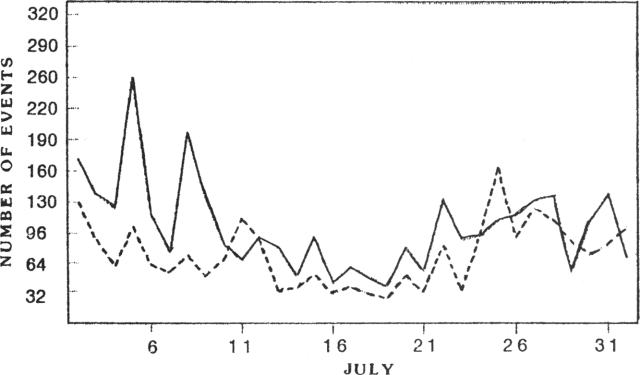Report on Nevado del Ruiz (Colombia) — July 1989
Scientific Event Alert Network Bulletin, vol. 14, no. 7 (July 1989)
Managing Editor: Lindsay McClelland.
Nevado del Ruiz (Colombia) Seismicity decreases; new summit depression
Please cite this report as:
Global Volcanism Program, 1989. Report on Nevado del Ruiz (Colombia) (McClelland, L., ed.). Scientific Event Alert Network Bulletin, 14:7. Smithsonian Institution. https://doi.org/10.5479/si.GVP.SEAN198907-351020
Nevado del Ruiz
Colombia
4.892°N, 75.324°W; summit elev. 5279 m
All times are local (unless otherwise noted)
After a sharp increase in seismicity on 24 June and a small ash emission 2 days later, seismicity gradually decreased in late June. High- and low-frequency events stabilized at 200-300/day by the end of the month (figure 28), and tremor was almost absent. A depression, 150-200 m in diameter and 80 m deep, apparently formed on 26 June ~50-100 m SW of the principal (Arenas) crater. It probably developed because of high-pressure gas emission and destabilization of the walls of Arenas crater.
 |
Figure 28. Daily number of high- and low-frequency events at Ruiz, July 1989. Courtesy of the the Observatorio Vulcanológico de Colombia. |
Deformation measurements showed no significant changes in July. SO2 flux averaged 1,200 t/d, a slight increase from May (1,046 t/d) and June.
Geological Summary. Nevado del Ruiz is a broad, glacier-covered volcano in central Colombia that covers more than 200 km2. Three major edifices, composed of andesitic and dacitic lavas and andesitic pyroclastics, have been constructed since the beginning of the Pleistocene. The modern cone consists of a broad cluster of lava domes built within the caldera of an older edifice. The 1-km-wide, 240-m-deep Arenas crater occupies the summit. The prominent La Olleta pyroclastic cone located on the SW flank may also have been active in historical time. Steep headwalls of massive landslides cut the flanks. Melting of its summit icecap during historical eruptions, which date back to the 16th century, has resulted in devastating lahars, including one in 1985 that was South America's deadliest eruption.
Information Contacts: C. Carvajal, INGEOMINAS, Manizales.

